Artificial intelligence (AI) is the science and engineering of creating machines and systems that can perform tasks that normally require human intelligence, such as vision, speech, reasoning, decision-making, and more. AI has been advancing rapidly in recent years, thanks to the availability of massive amounts of data, powerful computing hardware, and innovative algorithms and frameworks.
One of the key components that enable AI to achieve remarkable results is the graphics processing unit (GPU). A GPU is a specialized chip that was originally designed for rendering graphics and video games. However, researchers and developers soon discovered that GPUs are also very efficient at performing mathematical operations on large arrays of data, which are essential for many AI applications.
By using GPUs, AI practitioners can accelerate their workloads and achieve faster training and inference of their models. GPUs can handle parallel computations much better than general-purpose CPUs, which are limited by their sequential architecture. GPUs can also take advantage of dedicated hardware features, such as tensor cores and ray tracing cores, to boost their performance even further.
In this article, we will explore some of the most exciting and impactful applications of GPU-accelerated AI in various domains and industries. We will also compare and contrast different GPU options for AI and deep learning, such as NVIDIA Tesla V100, NVIDIA GeForce RTX 3090 Ti, NVIDIA Quadro RTX 4000, NVIDIA Titan RTX, NVIDIA RTX A5000, AMD Radeon Instinct MI100, Intel Arc Alchemist, etc. We will discuss their features, specifications, performance, advantages and disadvantages, and suitability for different scenarios and workloads. Finally, we will provide some recommendations and tips for choosing the best GPU for AI and deep learning based on your needs, budget, and preferences.
If you are an engineer who is interested in learning more about how GPUs can power up your AI projects and solutions, this article is for you. Let’s dive in!
GPU Options for AI and Deep Learning
In this section, we will compare and contrast different GPU options for AI and deep learning, such as NVIDIA Tesla V100, NVIDIA GeForce RTX 3090 Ti, NVIDIA Quadro RTX 4000, NVIDIA Titan RTX, NVIDIA RTX A5000, AMD Radeon Instinct MI100, Intel Arc Alchemist, etc. We will discuss their features, specifications, performance, advantages and disadvantages, and suitability for different scenarios and workloads. We will use tables, charts, and graphs to illustrate the data and comparisons.
NVIDIA Tesla V100
The NVIDIA Tesla V100 is the flagship GPU of the NVIDIA Volta architecture. It is designed for high-performance computing (HPC) and AI applications. It has 5120 CUDA cores, 640 tensor cores, 16 GB or 32 GB of HBM2 memory, and a memory bandwidth of 900 GB/s. It can deliver up to 125 teraflops of mixed-precision performance, 15.7 teraflops of single-precision performance, and 7.8 teraflops of double-precision performance.
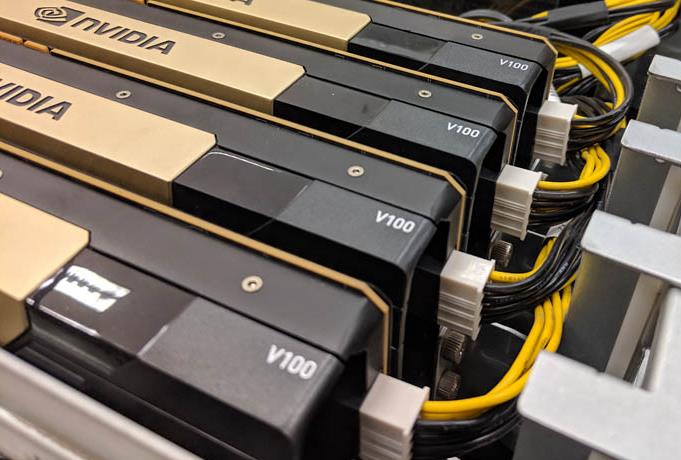 NVIDIA Tesla V100
NVIDIA Tesla V100
The NVIDIA Tesla V100 is ideal for large-scale AI training and inference workloads that require massive amounts of data and computation. It supports various deep learning frameworks, such as TensorFlow, PyTorch, MXNet, Caffe2, etc. It also supports NVIDIA’s CUDA-X software stack, which includes libraries and tools for AI, HPC, data science, graphics, etc.
The NVIDIA Tesla V100 is available in various form factors, such as PCIe cards, SXM2 modules, NVLink bridges, etc. It can also be integrated into various cloud platforms and servers, such as AWS EC2 P3 instances, Google Cloud TPU v3 instances, IBM Power Systems AC922 servers, etc.
The main advantages of the NVIDIA Tesla V100 are its high performance, scalability, compatibility, and versatility. It can handle a wide range of AI applications and workloads with ease and efficiency. It can also be scaled up to multiple GPUs using NVLink or NVSwitch technologies to achieve even higher performance and throughput. It can also work with various software frameworks and platforms to enable the seamless development and deployment of AI solutions.
The main disadvantages of the NVIDIA Tesla V100 are its high cost and power consumption. The NVIDIA Tesla V100 is one of the most expensive GPUs on the market, with a price tag of around $10K per card or $50K per server. It also consumes a lot of power, with a thermal design power (TDP) of 250 W or 300 W depending on the form factor. It also requires adequate cooling and ventilation to prevent overheating and throttling.
NVIDIA GeForce RTX 3090 Ti
The NVIDIA GeForce RTX 3090 Ti is the latest and most powerful GPU of the NVIDIA Ampere architecture. It is designed for gaming and content creation applications. It has 10496 CUDA cores, 328 tensor cores, 82 ray tracing cores, 24 GB of GDDR6X memory, and a memory bandwidth of 936 GB/s. It can deliver up to 285 teraflops of mixed-precision performance (with sparsity), 35.6 teraflops of single-precision performance (with sparsity), and 17.8 teraflops of double-precision performance (with sparsity).
The NVIDIA GeForce RTX 3090 Ti is suitable for medium-scale AI training and inference workloads that require high-quality graphics and video processing. It supports various deep learning frameworks, such as TensorFlow, PyTorch, MXNet, Caffe2, etc. It also supports NVIDIA’s CUDA-X software stack, which includes libraries and tools for AI, HPC, data science, graphics, etc.
The NVIDIA GeForce RTX 3090 Ti is available in various form factors, such as PCIe cards, water-cooled cards, etc. It can also be integrated into various desktops and laptops, such as ASUS TUF Gaming GeForce RTX 3090 Ti OC Edition, EVGA GeForce RTX 3090 Ti FTW3 Ultra Gaming, etc.
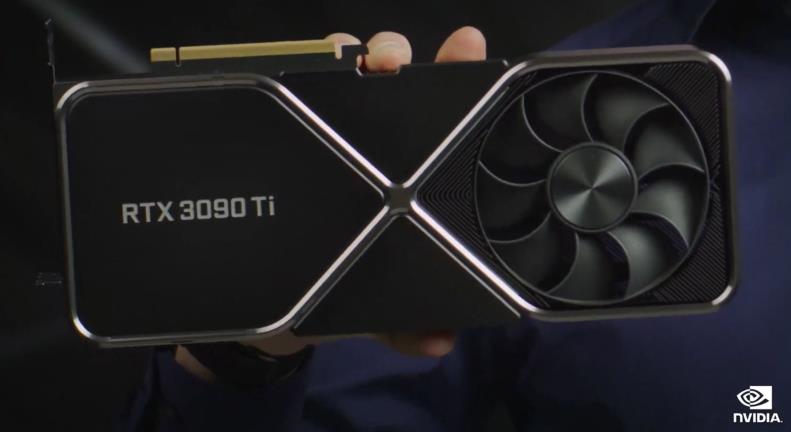 NVIDIA GeForce RTX 3090 Ti
NVIDIA GeForce RTX 3090 Ti
The main advantages of the NVIDIA GeForce RTX 3090 Ti are its high performance, compatibility, and versatility. It can handle a wide range of AI applications and workloads with ease and efficiency. It can also work with various software frameworks and platforms to enable the seamless development and deployment of AI solutions. It can also leverage its ray tracing cores and tensor cores to enhance the visual quality and performance of games and creative applications that support ray tracing and DLSS technologies.
The main disadvantages of the NVIDIA GeForce RTX 3090 Ti are its high cost and power consumption. The NVIDIA GeForce RTX 3090 Ti is one of the most expensive GPUs on the market, with a price tag of around $2K per card or $10K per desktop. It also consumes a lot of power, with a thermal design power (TDP) of 350 W or more depending on the form factor. It also requires adequate cooling and ventilation to prevent overheating and throttling. It also requires a high-end power supply unit (PSU) with multiple PCIe connectors to support its power draw.
NVIDIA Quadro RTX 4000
The NVIDIA Quadro RTX 4000 is a mid-range GPU of the NVIDIA Turing architecture. It is designed for professional applications that require high-performance graphics and compute capabilities. It has 2304 CUDA cores, 288 tensor cores, 36 ray tracing cores, 8 GB of GDDR6 memory, and a memory bandwidth of 416 GB/s. It can deliver up to 57 teraflops of mixed-precision performance (with sparsity), 7.1 teraflops of single-precision performance (with sparsity), and 3.5 teraflops of double-precision performance (with sparsity).
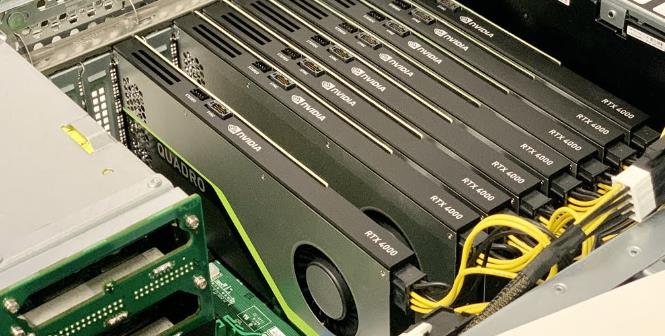 NVIDIA Quadro RTX 4000
NVIDIA Quadro RTX 4000
The NVIDIA Quadro RTX 4000 is suitable for small-scale AI training and inference workloads that require high-quality graphics and video processing. It supports various deep learning frameworks, such as TensorFlow, PyTorch, MXNet, Caffe2, etc. It also supports NVIDIA’s CUDA-X AI software stack, which includes libraries and tools for AI, HPC, data science, graphics, etc.
The NVIDIA Quadro RTX 4000 is available in a single-slot form factor that can fit into most desktops and workstations. It can also be integrated into various cloud platforms and servers, such as AWS EC2 G4 instances, Google Cloud T4 instances, Dell Precision 5820 Tower Workstation, etc.
The main advantages of the NVIDIA Quadro RTX 4000 are its versatility, compatibility, and reliability. It can handle a wide range of professional applications and workloads with ease and efficiency. It can also work with various software frameworks and platforms to enable the seamless development and deployment of AI solutions. It can also leverage its ray tracing cores and tensor cores to enhance the visual quality and performance of applications that support ray tracing and DLSS technologies. It also comes with enterprise-class features and support, such as NVIDIA nView desktop management software, NVIDIA Mosaic technology, NVIDIA GPUDirect support, Quadro Sync II compatibility, etc.
The main disadvantages of the NVIDIA Quadro RTX 4000 are its limited performance and memory capacity compared to higher-end GPUs. The NVIDIA Quadro RTX 4000 may not be able to handle large-scale AI workloads that require massive amounts of data and computation. It also has only 8 GB of memory, which may limit its ability to process complex models and datasets. It also consumes a significant amount of power, with a thermal design power (TDP) of 160 W or more depending on the workload. It also requires adequate cooling and ventilation to prevent overheating and throttling.
NVIDIA Titan RTX
The NVIDIA Titan RTX is a high-end GPU of the NVIDIA Turing architecture. It is designed for researchers, developers, and creators who need the ultimate performance and memory capacity for their AI and professional applications. It has 4608 CUDA cores, 576 tensor cores, 72 ray tracing cores, 24 GB of GDDR6 memory, and a memory bandwidth of 672 GB/s. It can deliver up to 130 teraflops of mixed-precision performance (with sparsity), 16.3 teraflops of single-precision performance (with sparsity), and 8.1 teraflops of double-precision performance (with sparsity).
 NVIDIA Titan RTX
NVIDIA Titan RTX
The NVIDIA Titan RTX is suitable for large-scale AI training and inference workloads that require massive amounts of data and computation. It supports various deep learning frameworks, such as TensorFlow, PyTorch, MXNet, Caffe2, etc. It also supports NVIDIA’s CUDA-X AI software stack, which includes libraries and tools for AI, HPC, data science, graphics, etc.
The NVIDIA Titan RTX is available in a dual-slot form factor that can fit into most desktops and workstations. It can also be integrated into various cloud platforms and servers, such as AWS EC2 P3dn instances, Google Cloud T4 instances, Dell Precision 7920 Tower Workstation, etc.
The main advantages of the NVIDIA Titan RTX are its unparalleled performance and memory capacity. It can handle the most demanding AI applications and workloads with ease and efficiency. It can also work with various software frameworks and platforms to enable the seamless development and deployment of AI solutions. It can also leverage its ray tracing cores and tensor cores to enhance the visual quality and performance of applications that support ray tracing and DLSS technologies. It also comes with enterprise-class features and support, such as NVIDIA nView desktop management software, NVIDIA Mosaic technology, NVIDIA GPUDirect support, Quadro Sync II compatibility, etc.
The main disadvantages of the NVIDIA Titan RTX are its high cost and power consumption. The NVIDIA Titan RTX is one of the most expensive GPUs on the market, with a price tag of around $2.5K per card or $12.5K per desktop. It also consumes a lot of power, with a thermal design power (TDP) of 280 W or more depending on the workload. It also requires adequate cooling and ventilation to prevent overheating and throttling. It also requires a high-end power supply unit (PSU) with multiple PCIe connectors to support its power draw.
NVIDIA RTX A5000
The NVIDIA RTX A5000 is a high-end GPU of the NVIDIA Ampere architecture. It is designed for professional applications that require high-performance graphics and computing capabilities. It has 8192 CUDA cores, 256 tensor cores, 64 ray tracing cores, 24 GB of GDDR6 memory with ECC, and a memory bandwidth of 768 GB/s. It can deliver up to 65 teraflops of mixed-precision performance (with sparsity), 27.8 teraflops of single-precision performance (with sparsity), and 13.9 teraflops of double-precision performance (with sparsity).
The NVIDIA RTX A5000 is suitable for large-scale AI training and inference workloads that require massive amounts of data and computation. It supports various deep learning frameworks, such as TensorFlow, PyTorch, MXNet, Caffe2, etc. It also supports NVIDIA’s CUDA-X AI software stack, which includes libraries and tools for AI, HPC, data science, graphics, etc. It also supports NVIDIA’s NGC catalog, which is a hub of GPU-optimized AI, HPC, and data analytics software that simplifies and accelerates end-to-end workflows.
The NVIDIA RTX A5000 is available in various form factors, such as PCIe cards, mobile workstations, etc. It can also be integrated into various cloud platforms and servers, such as AWS EC2 G4ad instances, Google Cloud A2 instances, Lenovo ThinkStation P620 Workstation, etc.
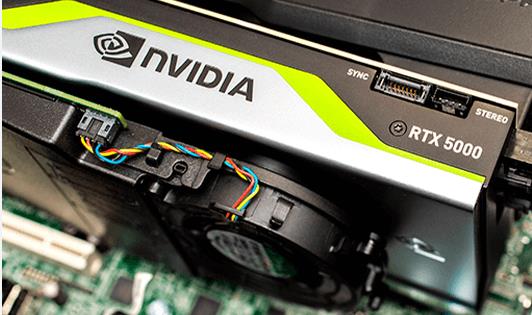 NVIDIA RTX A5000
NVIDIA RTX A5000
The main advantages of the NVIDIA RTX A5000 are its high performance, scalability, compatibility, and reliability. It can handle a wide range of professional applications and workloads with ease and efficiency. It can also work with various software frameworks and platforms to enable the seamless development and deployment of AI solutions. It can also leverage its ray tracing cores and tensor cores to enhance the visual quality and performance of applications that support ray tracing and DLSS technologies. It can also scale memory and performance across multiple GPUs with NVIDIA NVLink technology to tackle larger datasets, models, and scenes. It also comes with enterprise-class features and support, such as NVIDIA nView desktop management software, NVIDIA Mosaic technology, NVIDIA GPUDirect support, Quadro Sync II compatibility, etc.
The main disadvantages of the NVIDIA RTX A5000 are its high cost and power consumption. The NVIDIA RTX A5000 is one of the most expensive GPUs on the market, with a price tag of around $2K per card or $10K per workstation. It also consumes a lot of power, with a thermal design power (TDP) of 230 W or more depending on the workload. It also requires adequate cooling and ventilation to prevent overheating and throttling. It also requires a high-end power supply unit (PSU) with multiple PCIe connectors to support its power draw.
AMD Radeon Instinct MI100
The AMD Radeon Instinct MI100 is a high-end GPU of the AMD CDNA architecture. It is designed for high-performance computing (HPC) and AI applications. It has 7680 stream processors, 120 compute units, 32 GB of HBM2 memory, and a memory bandwidth of 1.23 TB/s. It can deliver up to 11.5 teraflops of double-precision performance (FP64), 23.1 teraflops of single-precision performance (FP32), and 184.6 teraflops of half-precision performance (FP16).
The AMD Radeon Instinct MI100 is suitable for large-scale AI training and inference workloads that require massive amounts of data and computation. It supports various deep learning frameworks, such as TensorFlow, PyTorch, MXNet, Caffe2, etc. It also supports AMD’s ROCm open software platform, which includes libraries and tools for AI, HPC, data science, graphics, etc. It also supports Microsoft’s DeepSpeed library, which enables efficient large-model training on AMD GPUs with hundreds of billions of parameters.
The AMD Radeon Instinct MI100 is available in various form factors, such as PCIe cards, OAM modules, etc. It can also be integrated into various cloud platforms and servers, such as AWS EC2 G4ad instances, Google Cloud A2 instances, HPE Apollo 6500 Gen10 Plus System, etc.
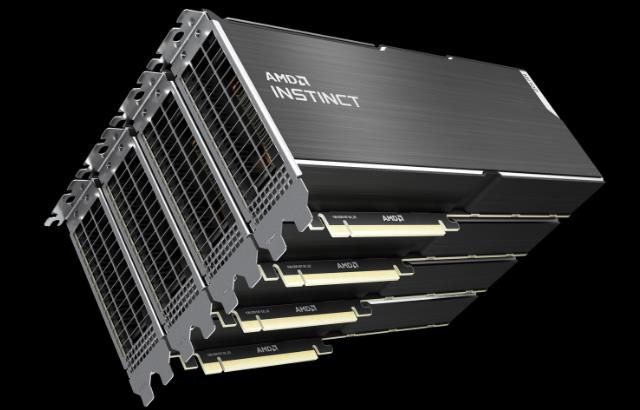 AMD Radeon Instinct MI100
AMD Radeon Instinct MI100
The main advantages of the AMD Radeon Instinct MI100 are its high performance, scalability, compatibility, and versatility. It can handle a wide range of AI applications and workloads with ease and efficiency. It can also work with various software frameworks and platforms to enable the seamless development and deployment of AI solutions. It can also scale memory and performance across multiple GPUs with AMD Infinity Fabric technologyto tackle larger datasets, models, and scenes. It also supports various precision modes and mixed-precision operations to optimize performance and accuracy for different AI tasks.
The main disadvantages of the AMD Radeon Instinct MI100 are its high cost and power consumption. The AMD Radeon Instinct MI100 is one of the most expensive GPUs on the market, with a price tag of around $7K per cardor $35K per server. It also consumes a lot of power, with a thermal design power (TDP) of 300 W or more depending on the workload. It also requires adequate cooling and ventilation to prevent overheating and throttling. It also requires a high-end power supply unit (PSU) with multiple PCIe connectors to support its power draw.
Intel Arc Alchemist
The Intel Arc Alchemist is the first GPU of the Intel Arc architecture. It is designed for gaming and content creation applications. It has 512 execution units, 16 XMX cores, 16 GB of GDDR6 memory, and a memory bandwidth of 256 GB/s. It can deliver up to 16 teraflops of single-precision performance (FP32), 8 teraflops of double-precision performance (FP64), and 32 teraflops of half-precision performance (FP16).
The Intel Arc Alchemist is suitable for medium-scale AI training and inference workloads that require high-quality graphics and video processing. It supports various deep learning frameworks, such as TensorFlow, PyTorch, MXNet, Caffe2, etc. It also supports Intel’s XeSS technology, which is an AI-enhanced super sampling technique that upscales games from a lower resolution to provide smoother frame rates without a noticeable compromise in image quality. XeSS can work with or without the XMX cores, which are dedicated hardware units for AI processing.
The Intel Arc Alchemist is available in various form factors, such as PCIe cards, mobile GPUs, etc. It can also be integrated into various desktops and laptops, such as ASUS ROG Strix G15 Arc Edition, MSI Stealth 15M Arc Edition, etc.
 Intel Arc Alchemist
Intel Arc Alchemist
The main advantages of the Intel Arc Alchemist are its compatibility, versatility, and innovation. It can handle a wide range of gaming and creating applications and workloads with ease and efficiency. It can also work with various software frameworks and platforms to enable the seamless development and deployment of AI solutions. It can also leverage its XMX cores and XeSS technology to enhance the visual quality and performance of games and creative applications that support super-sampling technologies. It also supports DirectX 12 Ultimate and hardware-based ray tracing with support for both DirectX Raytracing (DXR) and Vulkan Ray Tracing.
The main disadvantages of the Intel Arc Alchemist are its limited performance and memory capacity compared to higher-end GPUs. The Intel Arc Alchemist may not be able to handle large-scale AI workloads that require massive amounts of data and computation. It also has only 16 GB of memory, which may limit its ability to process complex models and datasets. It also consumes a significant amount of power, with a thermal design power (TDP) of 175 W or more depending on the workload. It also requires adequate cooling and ventilation to prevent overheating and throttling. It also requires a high-end power supply unit (PSU) with multiple PCIe connectors to support its power draw.
Conclusion
In this article, we have explored some of the most exciting and impactful applications of GPU-accelerated AI in various domains and industries. We have also compared and contrasted different GPU options for AI and deep learning, such as NVIDIA Tesla V100, NVIDIA GeForce RTX 3090 Ti, NVIDIA Quadro RTX 4000, NVIDIA Titan RTX, NVIDIA RTX A5000, AMD Radeon Instinct MI100, Intel Arc Alchemist, etc. We have discussed their features, specifications, performance, advantages and disadvantages, and suitability for different scenarios and workloads.
We hope that this article has provided you with useful information and insights to help you choose the best GPU for AI and deep learning based on your needs, budget, and preferences. As the field of AI continues to evolve and advance, so will the GPU technologies that power it. We look forward to seeing more innovations and breakthroughs in the future that will enable new possibilities and discoveries for humanity. Thank you for reading!
FAQs
Q: What is the role of a GPU in AI?
A: GPUs accelerate AI computations by processing parallel tasks more efficiently than traditional CPUs.
Q: Why is a GPU important for AI training?
A: GPUs excel at handling the large-scale matrix operations required for training deep neural networks, significantly reducing training time.
Q: Can I use a CPU instead of a GPU for AI?
A: While CPUs can perform AI tasks, GPUs are specifically designed to accelerate AI workloads, delivering significantly faster results.
Q: What are the benefits of using a GPU for AI inference?
A: GPUs enable real-time inference by swiftly executing complex computations, making them ideal for applications that require quick responses.
Q: How do GPUs enhance AI performance?
A: GPUs leverage their parallel processing capabilities to perform multiple calculations simultaneously, drastically speeding up AI computations.
Q: Are all GPUs suitable for AI applications?
A: Not all GPUs are designed for AI. It’s essential to choose GPUs with specialized architectures, such as NVIDIA’s CUDA cores, optimized for AI workloads.
Q: Can I use multiple GPUs for AI?
A: Yes, utilizing multiple GPUs in parallel can further enhance AI performance, allowing for faster training and more complex AI models.